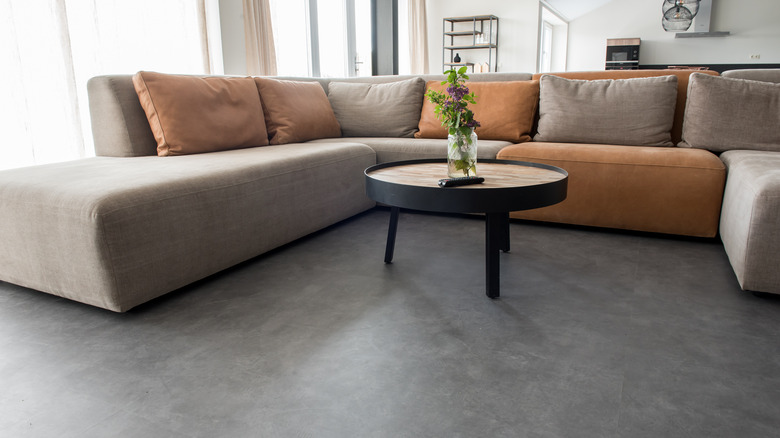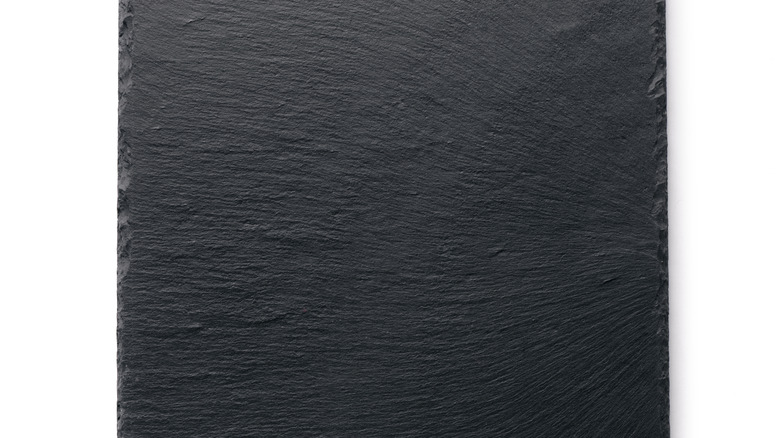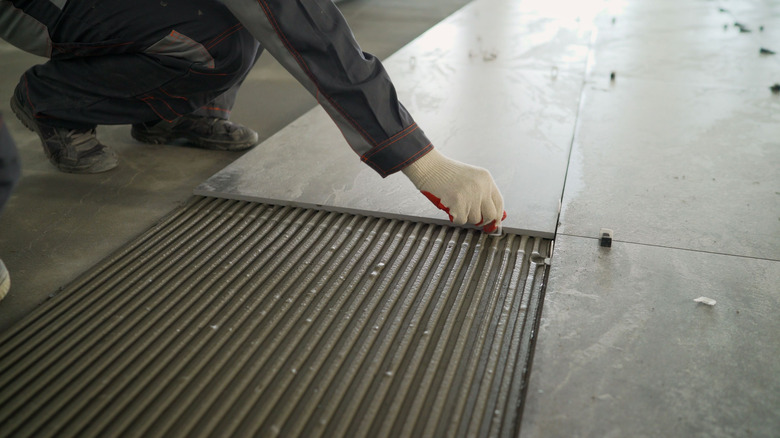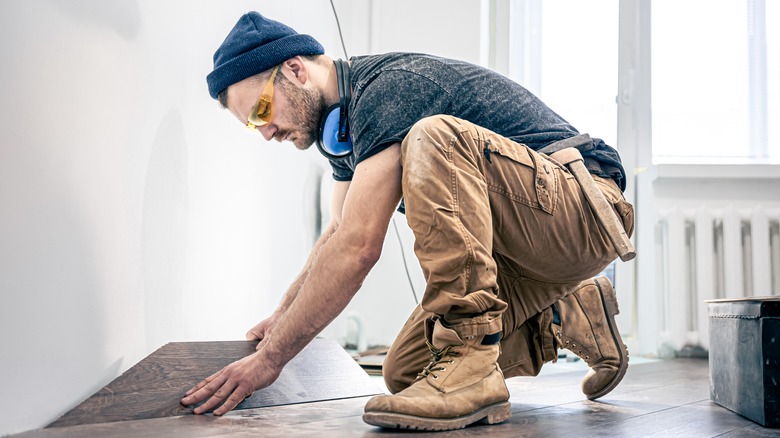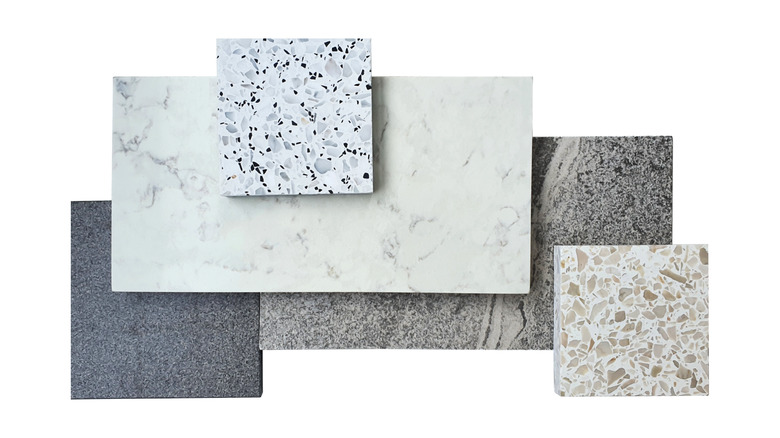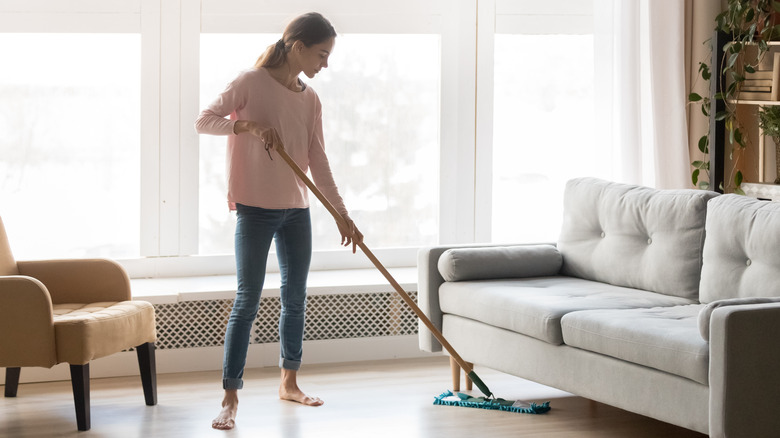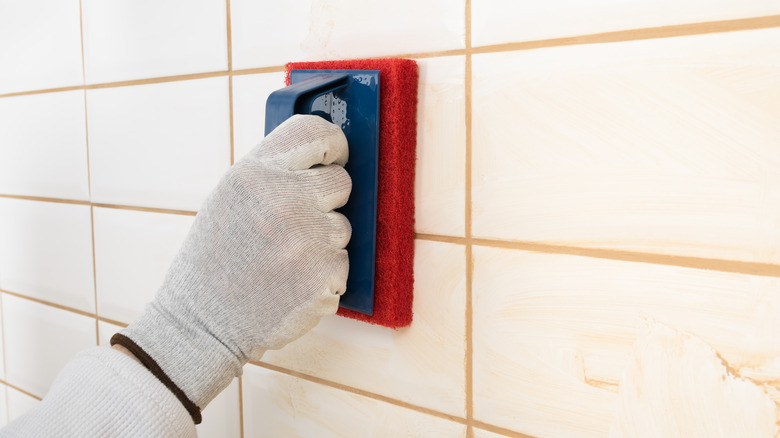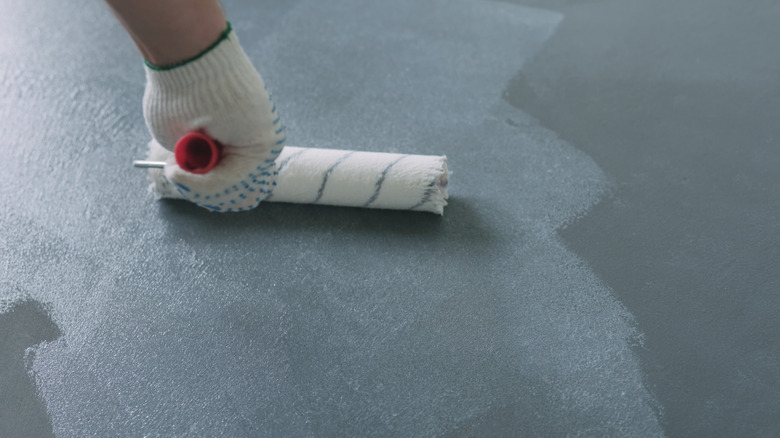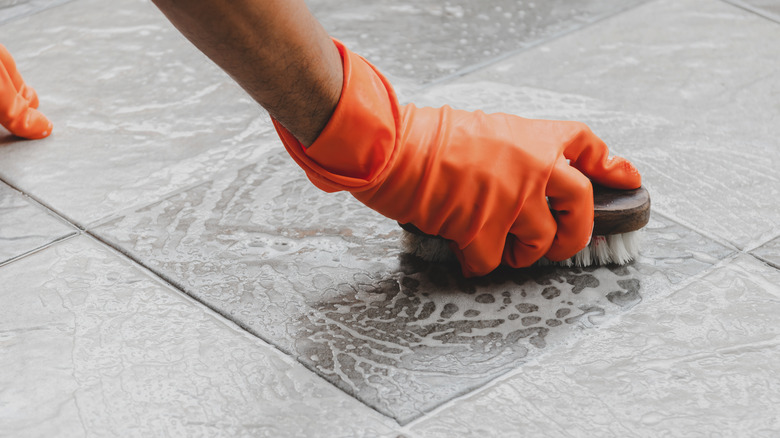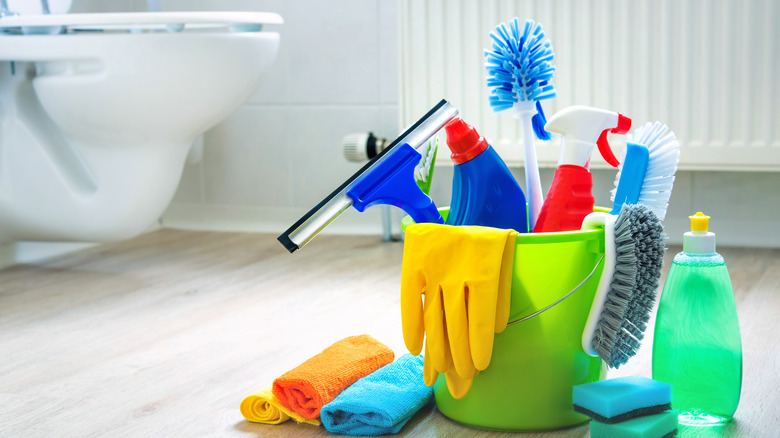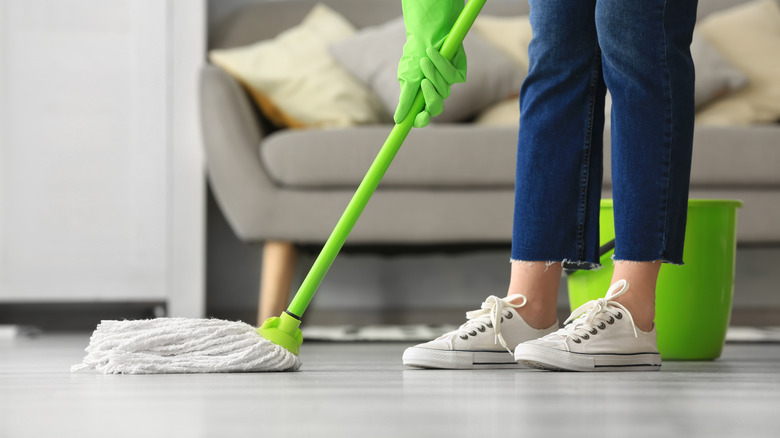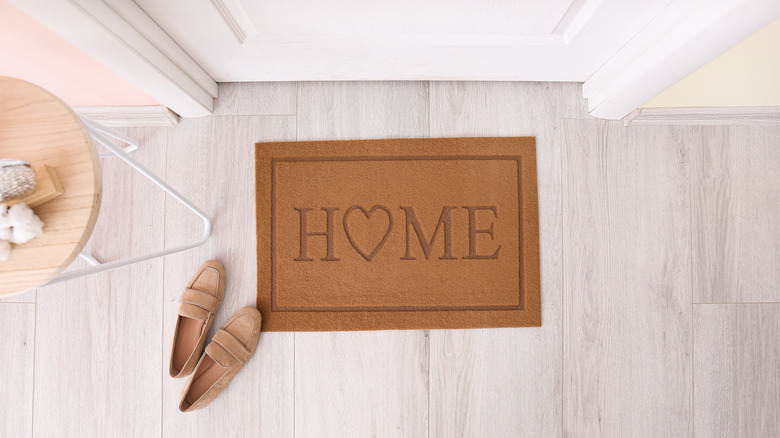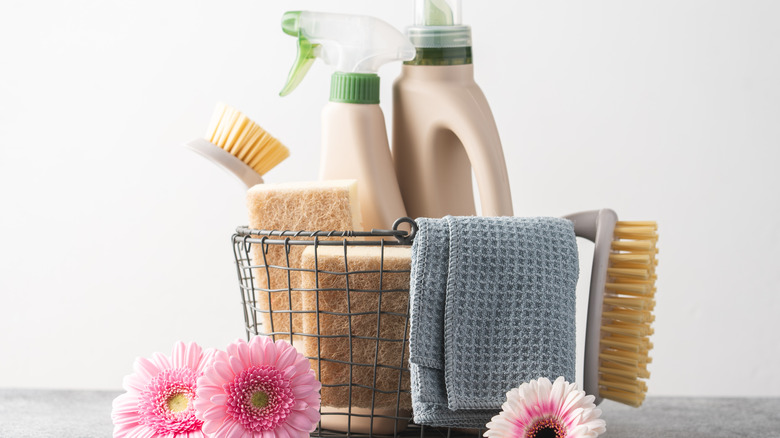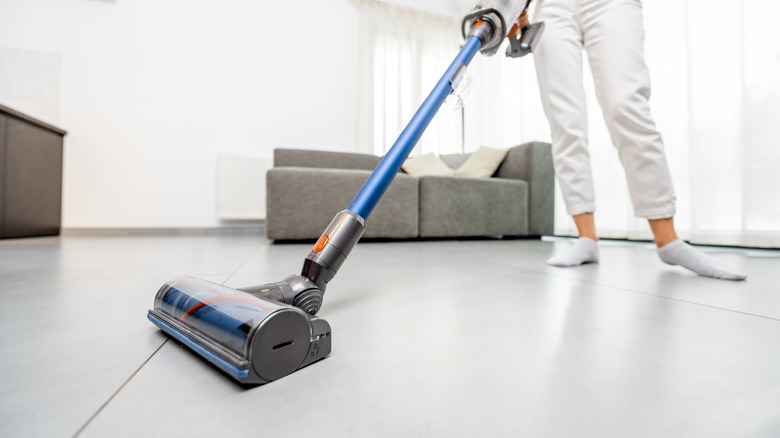How To Clean And Care For Slate Flooring
Slate flooring is a cool and classy way to add something special to your home. But what exactly is it, and how can you best take care of it? Slate flooring is, like the name suggests, made from slate rock. According to Floor Coverings International, slate is a metamorphic rock, which means it's an aggregate material formed by being compressed over long periods of time. It gets sourced from mountains across the world, and then it is cut into slabs for things like roofs or floor tiles.
Slate floorings come in many different colors, such as black or gray, blue or green tones, or even reddish-brown and dark purple. Slate also comes both "gauged," and "ungauged." Ungauged slate is the stone's more natural state, so it's rougher, more uneven, and usually used outdoors. Gauged slate is easier to install indoors and has even surfaces. Once you decide what kind of slate flooring you will install, here is a handy guide on how to clean and maintain them.
Pros of slate flooring
There are many reasons people choose to install slate flooring in their homes. Because of how it's formed, slate is very durable and lasts a long time if properly taken care of, even in areas in a home that receive a lot of traffic. The different color options of natural slate give homeowners options to choose from, so many people can find a color that looks good in their home or achieves the desired design aesthetic. It's versatile in design, so it can look both modern or more traditional depending on how one uses it in their home.
According to Claude Brown's, slate can increase the value of your home. Though it can be pricey to install, slate floors are considered high-end flooring, so it increases the house's overall value (while also looking classy, of course). Another benefit is that slate is ideal for heating systems, allowing you to add heated tiles to your bathroom. So if you think that a stone flooring might be cold, think again!
Cons of slate flooring
As previously mentioned, one of the downsides of a slate floor is that it's a bit of an investment. The costs of slate floors vary depending on the quality and specifics, but the slate itself can run on the pricier side. That number increases when you have it professionally installed. However, having it professionally installed is recommended by many flooring experts and outlets, like Claude Brown's. If you don't have the right tools, cutting, resizing, and laying down slate can be difficult and time-consuming. Slate is also a brittle stone, so it can crack if you aren't careful.
Additionally, slate floors require regular upkeep to keep them looking spiffy. If it's not maintained well, it can easily get worn down or scratched, and because it's a porous stone, stains can settle into the stone if it isn't sealed well. This makes removing stains particularly tough. Slate is also unique, so each stone might be different. This can be a good thing if you want to add something special to your home, but it makes it difficult to replace any damaged tiles, as it may give a mismatched appearance if you can't find a good match.
Cost of slate floors
One of the main cons to getting a slate floor is the price, even though it will increase the overall value of a home. According to HomeAdvisor, there are a lot of factors that come into play, so prices can vary. But an 800-square-foot space can cost, on average, $10,400 to put a slate floor into. Slate tiles cost $4 per square foot, though more luxury brands offer tiles at as much as $28 per square foot.
The tile and stone brand Emser offers slate floors at $3 to $6 per square foot, which is the average range you will see. Other brands include names like Bedrosians, Daltile, Interceramic, MIS, and Stone & Tile Shoppe. There are many factors that determine how affordable or expensive the slate floor will run. For example, slate floors installed on anything other than the main floor will need additional reinforcement. Overall, the costs will change depending on your budget and how much you feel comfortable spending on materials and installation.
DIYing slate floor installation
Can you DIY slate floors? Do-It-Yourself, or DIY, is now a popular philosophy for all things home design. It can be a great way to save money by finding ways to do things yourself, from upholstering couches to screening patios. Sometimes, though, it may be better to splurge on professional assistance. Slate floors are one of those things that can be hard to DIY, so if you don't have a lot of home-building experience, it may be better to sit this one out, as per Claude Brown's. If you are going to do it, Bob Vila recommends being well-stocked with carpenter tools and "specialty tools." These are things like cement board clippers, diamond blades, and wet tile saws.
Additionally, the substrate needs to be "rock-solid." How solid is rock-solid? At least five layers of substrate, it turns out. You also need grout to install tile, and when it comes to slate floors, you should apply some type of sealant before grouting, otherwise that porous stone can soak some of it up.
Different types of slate
There are a few different ways to classify types of slate floor tiles. There are different types depending on the backing of the tiles and the facing of the tyles. According to More Surface, gauged and ungauged slate refers to the backing of the tiles. Ungauged is the natural stone and has a rough and uneven backing. Gauged is smoothed on the back, so it fits together evenly when used indoors. The publication also lists the types of faces when dealing with slate: cleft, tumbled, honed, and polished.
Cleft slate is the natural face of the stone, so there are varieties in the appearance, like lines and other patterns. The natural stone is the most durable. Tumbled slate has a less-jagged finish. It typically has rounded corners and a little bumpiness to its surface. Honed slate is another very smooth-surfaced slate tile. Because it's so flat and sleek, honed slate is ideal for a modern look. Lastly, polished slate is the most smooth and also the most rare type of slate. It has a shiny, marble-like appearance, and is also the most brittle.
Dust-mopping slate floors
The best, and easiest, way to maintain a good-looking slate floor is by dust-mopping regularly. according to The Spruce, a dust mop is a simple but effective tool for clearing up dust and other small things like pet hair or dirt. The dust mop, which is also called a dry mop, is never meant to be wet, so don't go dipping it into any buckets! It's more like a giant duster for the floor, and is great for keeping high-traffic areas nice and shiny. By removing these little particles, you're reducing the likelihood that they get dragged along the slate, therefore making little scratches. It may seem easy to overlook, but these small particles and the scratches they make accumulate over time and give that worn-down appearance to tiles over time.
To dust-mop properly, just remove any furniture or mats out of the way and work the mop from end-to-end of the room in long, straight-lines. Keep dust and other debris in front of the mop and be sure to get corners cleaned out, too. Then, you can take the mop outside and shake it out. If the dust-mop is especially dirty, swap out the head for a clean one. Some mop heads are washing-machine safe as well.
Sealing slate flooring for lasting cleanliness
If your slate floors are unsealed, they should be sealed to protect them from stains or other damages. The Spruce notes that sometimes, because of things like discoloration or wear and tear over time, slate floors will have to be re-sealed. If this is the case, slate floors need to be dust-mopped and vacuumed, as well as clear of any furniture, so they're nice and clean for sealing. Then, you can pick which sealer you like, but this will change depending on exactly what type of slate you have or what you want out of it. The publication explains that there are two types of sealers: a "below-surface" sealer that is absorbed by the material, and a "surface" sealer that lays down a coat on top of the stone and has a "more visible finish."
A tub and a sponge is a common way to apply sealer. Simply use the sponge to apply a thin layer of the sealer onto the slate floors by moving the sponge in a circular motion over the tile and the grout. Work in small areas to keep track of what has been sealed and what hasn't. Then, you can buff the freshly-sealed tiles with a cloth. Sometimes, a second coat of sealer is necessary, but check the instructions on your sealer product for the best result.
Best sealants on the market
As mentioned before, there are two main types of sealants: below-surface sealer (also known as impregnator or porous sealer) and surface sealer (also called barrier sealer). When picking a sealer, the main concern is whether it's going to change the appearance of your slate floors or not. Some people prefer the natural stone look, while others might want the modern look of a glossy floor. The below-surface sealer is best for keeping the natural look, according to MSI Surfaces. It doesn't change anything about the color or texture, and MSI recommends a water-based sealer that will get absorbed deep into the stone. You won't even know it's there!
Some surface sealers are considered "enhancing," in that it changes the way the floors look, either by making them glossy or brighter in color. But they not only change the appearance of stone — it also might protect it better. Solvent-based sealers are more durable, so that's something to remember if you want a topical glossy sealer to give your slate floors that shiny, polished look. StonesProtect recommends the Tuff Duck sealer, as well as other brands like Miracle Sealants, Granite Gold, Aqua Mix, and Tenax. Every few years, a sealant will accumulate discoloration or normal wear and tear, so it should be stripped and reapplied.
How to prevent stains and scratches
The best way to prevent scratches is by regularly dust-mopping and sweeping, but using a gentle broom or a vacuum is also a good way to get rid of dust and dirt before it scratches the floor. If you already have noticed some scratches on your slate floors, there are a few different ways you can remove them. Slate U.K. explains that mineral oil is great for hiding any scratches or scuffs by darkening them. All you need to do is work the mineral oil onto the area using a cloth. Other recommendations include a stain pen. These come in a variety of colors, so you should be able to find one that matches your slate. Lastly, sanding is always an option. A fine-grit sandpaper can buff out scratches and return the slate to its former glory.
Removing stains from slate floors can be a bit tricky. Since the stone is porous, it will absorb liquids if you aren't quick to wipe them up. A mild detergent is a good starting place to get rid of a stain, but if that doesn't work, you can try hydrogen peroxide or rubbing alcohol as well.
Strip your slate floors
Before you strip anything from your slate floors, you should know what's on top of it. According to Stone World, that can either be a sealant, wax, acrylic, or epoxy. You can perform different tests to see what will strip the floor and determine what is on it, and if you know what's on it, you can go to a product page to learn how best to strip it. A water-based coating is easily stripped with any commercial stripper you might find at the store. However, other slate finishers, like a urethane-based coating, are going to be much more difficult to remove. At that point, you may want to get professional help.
An alkaline stripper can easily remove an acrylic-based finish, but you will need a professional floor buffer for the process. If you want to avoid a film, mix some neutral cleaner with water and rinse the floor after stripping. To strip the floor of a urethane finish, be sure to ventilate the area, as strippers that are meant for urethanes have chemicals that can be dangerous. Be sure to read and follow all product instructions.
How often you need to clean the flooring
Regular upkeep of a slate floor is necessary, but it doesn't have to be hard. Maintaining the floors little by little over time will prevent everyday wear and tear and increase the floor's longevity overall, so the classy appearance lasts much longer. Dust-mopping daily, especially in high-traffic parts of the floor, will reduce scuffs. Slate floors are typically sealed when they get installed, and this should last up to 15 years, according to Tile Cleaners. If your home came with slate floors, it might be worth asking how old the sealant is or getting recommendations from an expert. Aside from the initial seal, an average surface sealer will last around three years.
When it comes to wet mopping, it depends on how much traffic the floors get. Keep an eye on the floors to see when the appearance begins to change from clean-looking to perhaps a bit more dull and worn. If you have a busy home, you may need to wet mop once or twice a week. For a quieter home or in low-traffic areas, such as a laundry room, you can wet mop once every other week.
What daily care looks like
For the day-to-day care of your slate floors, dust-mopping is once again the star of the show. It's easy to forget about, but it's simply the best way to ensure that your floors will last a long time and look as good as new. If you have new floors, MSI Surfaces explains that sweeping every day is especially necessary. New slate floors go through a process called "spalling." This is when little chips come off the surface of the slate tiles. It may seem like the slate is flaking, but this is a normal process for newly-installed slate, and will stop once the slate "settles in."
Other things you can do to reduce day-to-day wear on the floors are using mats or rugs in high-traffic areas. Something as simple as a walk-in mat can drastically reduce the amount of debris tracked into the home, which will help keep your floors much cleaner over time. You can't have too many, really — mats both inside the house and outside will keep the dirt off the floor. Stone World recommends cleaning mats daily, if you have the time, and sweeping under them when cleaning.
The do's of slate floor maintenance
The main takeaways for maintaining slate flooring are pretty simple. Prevention of harm to the floor is important. Indoor mats or rugs will protect areas with heavy traffic. Dust-mopping frequently will reduce the likelihood of scratches. Make sure your sealer is up-to-date, and strip and replace it if necessary. Clean up spills, so they don't get absorbed into the stone.
If you want to go a little further, use a stone cleaner or another pH-neutral product to give your floor some extra shine, as per MSI Surfaces. Try to avoid doing anything that would cause undue wear on the stone, like moving chairs or other furniture. If you have pets, keep up after them regularly. For example, if you have a dog with long nails, it might cause some wear to the stone over time, so be sure to give your pup a nail trim. By putting this effort into maintaining your slate floors, they'll last a lot longer, and you won't need to replace any tiles.
The don't's of slate floor maintenance
There are definitely some things to keep in mind when cleaning and maintaining slate flooring as well so that you don't accidentally damage it in any way. According to MSI Surfaces, abrasive cleaners that contain vinegar, bleach, or lemon should be avoided. Additionally, any cleaning tools like brooms or vacuums should be adjusted for the flooring. A broom with a stiff bristle, for example, might wear on the stone, so a gentler-bristled broom is a better idea.
A vacuum cleaner set to a carpet setting, or a vacuum cleaner that has a beater bar on it, could similarly damage slate flooring. Don't try to polish, wipe down, or buff the tiles without dusting first, as you may inadvertently grind dust or dirt particles into the stone, which will act like sandpaper and scratch the tiles. As long as you keep these things in mind while maintaining your floors, you should be set to enjoy your beautiful slate floors!
